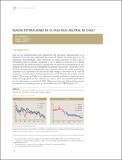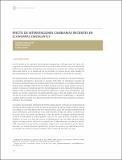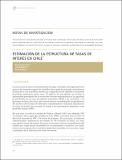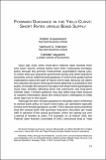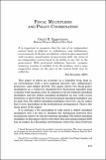Search
Now showing items 11-20 of 31
Nuevas estimaciones de la tasa real neutral de Chile
Una de las características más llamativas del escenario internacional es el bajísimo nivel que han alcanzado las tasas de interés de largo plazo en las economías desarrolladas. Este fenómeno se puede explicar en parte por la debilidad cíclica de dichas economías y de la agresiva respuesta de política ...
Efecto de intervenciones cambiarias recientes en economías emergentes
La alta liquidez en los mercados internacionales, generada por las bajas tasas de interés y los programas de relajamiento cuantitativo en las economías desarrolladas, junto con la fortaleza relativa de las economías emergentes, han contribuido al aumento de los flujos de capitales hacia estas últimas ...
Estimación de la estructura de tasas de interés en Chile
La estructura de tasas de interés permite recoger en tiempo real expectativas de agentes del mercado respecto de variables claves para la economía: movimientos futuros de la tasa de política monetaria y expectativas de inflación al horizonte de política monetaria, entre otras. El objetivo de este ...
Forward guidance in hte yield curve: short rates versis bond supply
Since late 2008 when short-term interest rates reached their zero lower bound central banks have been conducting monetary policy through two primary instruments: quantitative easing (QE) in which they buy long-term government bonds and other long-term securities and so-called forward guidance in which ...
Fiscal multipliers and policy coordination
This paper is about an economy in a liquidity trap that is an environment with a zero nominal interest rate deflationary pressures and subpar growth. The paper shows two fiscal policy multipliers in a relatively standard New Keynesian liquidity trap economy with taxation costs. It computes real ...
Macro-prudential policy and the conduct of monetary policy
The 'Great Contraction' in global economic activity triggered by the financial crisis and the extraordinary fiscal and monetary measures that public authorities had to undertake in order to put the economy back on track by putting public finances under heavy strains and leading to extremely low ...
Inflation targeting in financially stable economies: has it been flexible enough?
The international financial crisis and Great Recession of 2008- 09 called for a range of significant policy measures by central banks beyond aggressive interest rate cuts. Measures have ranged from improving international coordination to purchasing local private loan portfolios and direct intervention ...
Heterodox central banking
In response to the current global crisis the U.S. Federal Reserve and other central banks around the world have implemented diverse policy measures including purchasing a wide range of securities lending to financial institutions intervening in foreign exchange markets and paying interest on reserves. ...
Fiscal deficits debt and monetary policy in a liquidity trap
The dramatic policy response to the 2008-09 global economic crisis from many countries has revived some old debates about the use of fiscal and monetary policy in fighting recessions. The central dilemma for policy-makers in Japan North America and Europe has been to try to counter a large recession ...
Interest rate policies banking and the macroeconomy
The debate over the effectiveness of monetary policy often centers around the benefits of low interest rates as a stimulus for the real economy. The idea is that low interest rates encourage spending either in the form of consumption or investment and this promotes employment and production. The ...

